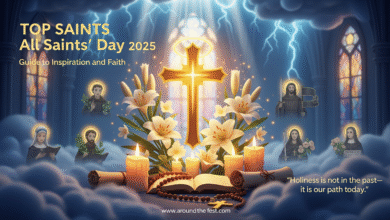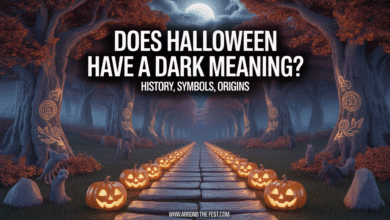Biblical Meaning and Origin of Christmas – History & Traditions
Biblical Meaning and Origin of Christmas – Rediscovering the True Meaning of Christmas

What if beneath every twinkling light, wrapped gift, and festive carol lies a story far deeper than tradition or tinsel? It is a story written long before Bethlehem’s manger scene was lit by a star. It is the heart of the Biblical Meaning and Origin of Christmas. This story echoes through the centuries as a divine invitation.
More Than a Holiday—The Heart of the Gospel

The biblical meaning of Christmas goes far beyond a cultural holiday or a season of family gatherings. It celebrates the birth of Jesus Christ, the promised Savior foretold in Scripture. This meaning reaches back to God’s promise in the Old Testament. It blooms in the Gospel accounts of Christ’s arrival—Emmanuel, “God with us” (Matthew 1:23).
Uncovering the True Story

Over the centuries, customs, legends, and traditions have intertwined with the biblical narrative. To understand the Christian origin and meaning of Christmas, we must peel back those layers. Only then can we see the shining heart of God’s redemptive plan. The history of Christmas celebrations reveals both the enduring message of hope and the cultural changes that have shaped how we mark December 25 today.
An Invitation to Go Deeper
This article invites you to step beyond the glittering surface. We will walk through the shepherds’ fields, hear the angels’ proclamation, and stand in awe at the manger. Together, we’ll explore:
- The biblical meaning of Christmas and its foundation in prophecy and the Gospels.
- How early Christians began to celebrate Christ’s birth and why these traditions spread.
- Practical, spirit-centered ways to honor the season in our homes and communities today.
Whether you have celebrated Christmas your whole life or are rediscovering it with fresh eyes, this journey can rekindle wonder and deepen faith. It can inspire celebrations that reflect why Christians mark Christmas—not just as a date on the calendar, but as a living testimony of God’s greatest gift to humanity. This gift is freely offered to all who believe.
The Biblical Meaning of Christmas

 When we talk about the biblical meaning of Christmas, we’re not just talking about shepherds under starry skies or angels singing in the night. It is more than a manger surrounded by animals. Christmas, in the Bible, is the breathtaking moment when God’s eternal plan entered human history in the most unexpected way—through the birth of a baby named Jesus.
When we talk about the biblical meaning of Christmas, we’re not just talking about shepherds under starry skies or angels singing in the night. It is more than a manger surrounded by animals. Christmas, in the Bible, is the breathtaking moment when God’s eternal plan entered human history in the most unexpected way—through the birth of a baby named Jesus.
The manger is not just the backdrop for a sentimental holiday scene. It is the opening chapter of the world’s most important rescue mission.
At its core, Christmas is about the Incarnation of Christ—God becoming human. This truth is so staggering that the early church never treated it as mere tradition. They saw it as the central miracle of the gospel. John writes, “The Word became flesh and lived among us” (John 1:14). Without the birth of Jesus, there would be no cross, no resurrection, and no salvation.
The Incarnation in Scripture

Two of the most detailed accounts of Jesus’ birth come from Luke 1–2 and Matthew 1–2. Together, they form a beautiful tapestry. These passages show how the birth of Jesus Bible story is more than history—it’s theology in motion.
In Luke’s account, we meet Mary—a young woman chosen to bear the Son of God. We also meet Joseph, a righteous man grappling with the weight of a divine calling. We see shepherds—ordinary, overlooked people—being the first to hear heaven’s announcement:
Luke records, “Today in the town of David, a Savior has been born to you; He is the Messiah, the Lord” (Luke 2:11).
Matthew’s Gospel adds another perspective. It traces Jesus’ lineage back to Abraham and David, showing that this child is the rightful heir to Israel’s promises. We meet the wise men, guided by a star, and Herod, threatened by a rival king. Matthew wants us to see that the Incarnation of Christ is not a random event. It is the climax of God’s carefully woven plan.
The word Immanuel— “God with us” (Matthew 1:23)—is not just poetic; it’s a reality that should stop us in our tracks. The God who created galaxies stepped into time and space. He came not as a warrior king in armor, but as a vulnerable infant. This is why the biblical meaning of Christmas invites both awe and worship. We celebrate not just a baby’s birth, but the arrival of the Creator in the form of His creation.
Prophetic Foundations
Long before Bethlehem’s stable, the Old Testament prophecies about Jesus pointed to a Messiah who would come at just the right time. Two stand out powerfully in the Christmas story:

Isaiah 7:14 – “The virgin will conceive and give birth to a son, and will call him Immanuel.”
Micah 5:2 says, “But you, Bethlehem Ephrathah, though you are small among the clans of Judah, out of you will come for Me one who will be ruler over Israel.”
These were not vague hopes—they were specific promises given centuries before Christ’s birth. When Matthew quotes Isaiah 7:14 in Matthew 1:23, he is showing that Messiah prophecy Christmas fulfillment is not coincidental. Bethlehem’s mention in Micah 5:2 is so exact that it leaves no doubt God had mapped out the location of the Messiah’s arrival long before history played it out.
These prophecies are not just “nice Christmas connections.” They are historical validation that the events of Luke and Matthew happened as part of a divine plan. Every fulfilled prophecy reinforces that Jesus is exactly who He claimed to be.
Christ as the Fulfillment of God’s Promise
 From the moment Adam and Eve fell in Genesis 3, God set in motion a redemption plan that threads through the entire Bible. The birth of Christ is not a standalone holiday—it’s the hinge of the Christmas gospel meaning that connects Eden’s lost promise to Revelation’s restored creation.
From the moment Adam and Eve fell in Genesis 3, God set in motion a redemption plan that threads through the entire Bible. The birth of Christ is not a standalone holiday—it’s the hinge of the Christmas gospel meaning that connects Eden’s lost promise to Revelation’s restored creation.
Jesus is the “Yes” and fulfillment of all God’s promises (2 Corinthians 1:20).. The child in the manger is the Lamb who would be slain, the King who would return, the Savior who would reconcile us to God. When we celebrate Christmas, we celebrate the day the Author stepped into His own story to bring it to its victorious conclusion.
Historical and Cultural Origins of Christmas: Biblical Meaning and Christian Traditions
Christmas didn’t just appear one December morning with tinsel, cocoa, and Bing Crosby. Its roots run deep—nearly two millennia—shaped by theological decisions, cultural shifts, and a compelling blend of sacred and secular traditions.
Early Church Fixes December 25 as Christmas Date: Biblical Meaning and Christian History of Christmas

By the 4th century, the early church officially fixed the celebration of Christ’s birth on December 25—but why choose that date?
The calculation theory suggests early Christians determined Jesus’s birth to be nine months after His conception on March 25. This aligns with the Feast of the Annunciation, a date traditionally linked to His death and the world’s redemption plan. Early church fathers such as Hippolytus of Rome and St. Augustine supported this view. This connects the Incarnation not only to history but to cosmic redemption. It symbolically unites Christ’s conception with the creation and salvation of the world (Catholic Echo, Wikipedia).
This key moment marked a foundational point in the Christian history of Christmas.
History of Religions Hypothesis and December 25 in the Christian History of Christmas and Its Biblical Meaning
 Another perspective, the history of religions hypothesis, suggests the church deliberately picked December 25 to provide a spiritual alternative to major pagan festivals such as Saturnalia and Sol Invictus, both celebrated near the winter solstice. However, scholars caution this is not conclusive.
Another perspective, the history of religions hypothesis, suggests the church deliberately picked December 25 to provide a spiritual alternative to major pagan festivals such as Saturnalia and Sol Invictus, both celebrated near the winter solstice. However, scholars caution this is not conclusive.
Historian Robert Hijmans argues that while the solstice was culturally important, it may not have been the definitive reason for Christmas’s date (Wikipedia).
This theory is part of the broader Christian history of Christmas and its development.
First Official Record and Christian Significance of December 25 in the Biblical Meaning and History of Christmas

The earliest known official record of December 25 as the date for celebrating Jesus’ birth appears in a Roman calendar from AD 336 during Emperor Constantine’s reign. This period marked Christianity’s rise from persecution to becoming a state-supported religion, enabling public and formal observance of Christmas.
Choosing December 25 connected the celebration to theological symbolism—the timing aligns roughly nine months after the Feast of the Annunciation on March 25, commemorating Jesus’ conception. This linked the Incarnation closely with God’s redemptive plan.
The designation of this date was significant in Christian history as it unified believers around a shared celebration honoring the profound biblical truth of God becoming flesh. This early milestone shaped the enduring tradition of Christmas as a sacred, joyous commemoration of Jesus’ birth.
Role of the Pax Romana in Spreading Christmas and Its Importance in the Christian History and Biblical Meaning of Christmas

The Pax Romana—meaning “Roman Peace”—was a period of relative stability and security across the Roman Empire that lasted about two centuries. This peaceful environment played a crucial role in spreading Christianity and establishing Christmas as a recognized celebration.
With safer travel routes and efficient communication networks, the good news of Jesus’ birth could reach distant regions more rapidly. The Pax Romana allowed early Christians to gather openly, share their faith, and integrate Christmas into community life without fear of persecution.
This historical backdrop helped embed the biblical meaning of Christmas—God’s incarnation and salvation plan—into the hearts and traditions of growing Christian populations. The stability fostered by the Pax Romana was essential for transforming Christmas from a small religious observance into a widespread, enduring holiday.
Biblical Meaning and Origin of Christmas – History & Traditions: Pagan Festivals and Christian Reframing Explored

While Christmas shares its December 25 date with ancient pagan festivals like Saturnalia and Sol Invictus, its true meaning is deeply rooted in the biblical story of Jesus’ birth. Early Christians intentionally chose this date to proclaim Jesus as the true “Light of the World,” transforming a season of nature worship into a celebration of God’s incarnation and salvation.
Symbols like evergreens and candles were given new meaning, representing eternal life and Christ’s light. This Christian reframing turned cultural customs into faith-filled traditions, emphasizing hope, redemption, and God’s love made flesh.
Christmas is thus more than a holiday—it’s a powerful testimony of faith triumphing over darkness and a reminder of God’s redemptive plan fulfilled in Jesus.
Saturnalia Festival’s Role in the Biblical Meaning and Origin of Christmas – Historical Context and Traditions

Saturnalia was among ancient Rome’s most beloved and lively festivals, held annually from December 17th to 23rd to honor Saturn, the god of agriculture, wealth, and time. This week-long holiday turned Roman society upside down with its joyful spirit, merrymaking, and social role reversals.
- Role Reversals During Saturnalia and Its Impact on Christmas Origins
Slaves and masters switched places during the festivities. Slaves enjoyed sumptuous banquets and gained the uncommon privilege to speak freely, while their masters humbly waited on them.
- Feasting, Revelry, and Decorations in Saturnalia
Public and private feasts featured abundant food, wine, and music. Homes and streets were adorned with lush greenery and glowing candles, casting a warm light to brighten the long winter nights.
- Gifts, Games, and Religious Observances in Saturnalia
People exchanged small gifts like wax candles, figurines, and sweets—similar to modern holiday gift-giving. Gambling, normally forbidden, was allowed, adding to the festival’s carefree atmosphere. Temples dedicated to Saturn opened to the public, and special sacrifices took place. Prayers were raised to Saturn, asking for abundance and prosperity in the year ahead.
The spirit of Saturnalia celebrated joy, social equality, and relaxation of usual rules. It honored abundance, renewal, and community togetherness at the darkest time of the year. Its lively customs influenced later winter festivals and holiday traditions worldwide.
Sol Invictus Festival and Its Impact on the Biblical Meaning and Origin of Christmas – History and Traditions

The Sol Invictus festival, meaning “Unconquered Sun,” was established by Roman Emperor Aurelian in AD 274 and celebrated on December 25. This festival honored the sun god and symbolized light’s victory over darkness during the winter solstice.
While some suggest that early Christians chose December 25 to coincide with Sol Invictus, the biblical meaning of Christmas centers on Jesus as the true Light of the World—God entering human history in flesh. Early Christians reframed the season, shifting focus from sun worship to Christ’s incarnation, offering a spiritual renewal and hope beyond pagan symbolism.
This blending of cultural context and Christian faith helped Christmas gain broader acceptance, transforming a common festival date into a profound celebration of divine light and salvation.
Christian Reframing of Pagan Festivals and Its Effect on the Biblical Meaning and Origin of Christmas – Historical Traditions

Instead of simply appropriating these pagan festivals, early Christians redeemed and reframed the date by proclaiming Jesus Christ as the true Light of the World, surpassing the sun’s symbolic power. This theological piv
ot shifted the focus from a celestial body to the Son of God (Wikipedia, History.com).
Church leaders also used the cultural timing strategically. By placing Christmas amid a season already filled with festivity, they provided believers with a joyful, Christ-centered alternative—not just replacing pagan customs but transforming the season’s meaning.
This reframing helped early Christians experience the season not as a time of mere revelry but as a profound spiritual celebration of divine redemption, illuminating the biblical meaning and origin of Christmas alongside its enduring history and traditions for generations to come.
Evolution of Christmas Traditions Over Centuries: Christian Origins and Cultural Adaptations
Over time, Christmas blossomed into a rich and varied tapestry of traditions—some rooted in Christian theology, others borrowed and adapted from local customs and cultures.
- Nativity Scenes: The very first living nativity scene was created by St. Francis of Assisi in 1223 in Greccio, Italy. His goal was to vividly and simply bring to life the humility and wonder of Christ’s birth for the local villagers (Good Catholic, National Catholic Register).
 Christmas Trees: Although the use of evergreens as winter decorations has pagan antecedents linked to solstice celebrations, the first documented Christmas tree is recorded in 1419 in Freiburg, Germany. In Christian symbolism, trees often depicted the Fall and Redemption, especially through scenes like Adam and Eve placed in or around the tree.
Christmas Trees: Although the use of evergreens as winter decorations has pagan antecedents linked to solstice celebrations, the first documented Christmas tree is recorded in 1419 in Freiburg, Germany. In Christian symbolism, trees often depicted the Fall and Redemption, especially through scenes like Adam and Eve placed in or around the tree.

Martin Luther is believed to have introduced the practice of placing candles on the Christmas tree, symbolizing Christ as the light shining in the darkness.
This heartfelt tradition spread more broadly thanks to Queen Victoria and Prince Albert, whose famous 1848 depiction of their decorated tree captured public imagination and helped establish the custom firmly within Western holiday celebrations.
- Christmas Carols: Originating in Latin during the medieval period, carols transitioned into vernacular languages, becoming a way to share the gospel in markets, churches, and homes. Their festive melodies and theological lyrics helped spread Christmas’s Christian message.
These traditions crossed continents through missionaries, migrants, and international trade, blending with local customs and evolving into the diverse celebrations enjoyed worldwide today (History.com, People.com, Wikipedia).

Theological Significance for Believers Today
Spiritual Reflection & Worship

The season of Advent is a sacred time for Christians worldwide to engage in profound spiritual reflection on the biblical meaning and origin of Christmas. Advent, meaning “coming,” focuses on the hopeful anticipation of Christ’s birth.
During this period, themes of hope, joy, peace, and love emerge. Each represents an essential aspect of the Messiah’s arrival and the promises fulfilled through Him.
However, in a world often overwhelmed by commercialism, the spiritual meaning of Christmas calls believers back to a Christ-centered celebration. It encourages worship that goes beyond outward festivities. Instead, the focus is on the heart of the holiday: the incarnation of God’s Son. Thus, the emphasis shifts from gifts and decorations to the true wonder of God’s love made flesh.
Consequently, believers are invited to participate in meaningful Christmas devotionals. Scripture readings, hymns, and prayers create a worshipful atmosphere honoring Jesus. Verses like Luke 2:14, “Glory to God in the highest, and on earth peace, goodwill toward men,” are often recited or sung. This practice reminds worshipers of the heavenly celebration at Jesus’ birth.
Moreover, many churches provide resources such as an Advent liturgy flowchart. This guides congregations through weekly themes and scripture, deepening the connection to Christ throughout the season. This intentional worship practice fosters a spirit of reverence and gratitude, helping believers internalize the true Christian Christmas worship experience.
Faith Applications

The biblical foundations of Christmas inspire heartfelt acts of love, kindness, and generosity. The incarnation not only reveals God’s love but also sets a powerful example for believers to follow. Therefore, acts of charity and service during Christmas become living testimonies of faith.
In addition, incorporating Christmas devotional ideas such as daily Scripture readings focused on Jesus’ birth and related promises proves helpful. Prayer times with family or church groups and reflective worship help believers live out the season’s meaning. These faith-based holiday traditions nurture a heart aligned with God’s will and foster spiritual growth.
For many, the season becomes a time to pause, reflect, and intentionally serve others. This may be through volunteering, giving to those in need, or simply showing kindness in everyday interactions. Ultimately, these practices embody the spiritual Christmas celebration and remind us that the holiday’s true joy comes from sharing God’s love.
Living Out the Gospel Message

Christmas offers a unique opportunity for evangelism—sharing the true meaning of Christmas message with others. The story of Christ’s birth is not only a celebration but also a call to proclaim God’s salvation to all.
During this season, believers can open conversations about faith, invite others to worship, and share the hope found in Jesus. The themes of light overcoming darkness and God’s love reaching humanity resonate deeply during the holidays.
Practical ways to share the gospel at Christmas include hosting festive gatherings with a spiritual focus, giving gifts that point to Christ’s message, or simply living with joy and generosity that attract others to the faith.
Furthermore, visual tools such as an Advent worship guide diagram or Bible verse overlays featuring John 1:14, “The Word became flesh and made his dwelling among us,” can inspire and educate both believers and seekers about the profound biblical meaning and origin of Christmas.
Common Misconceptions & Clarifications
Understanding Christmas can be complicated by myths and mixed messages. This section clarifies common misunderstandings by separating biblical truths from cultural practices and historical misconceptions, helping believers and seekers appreciate the true significance of Christmas.
Is Christmas “Biblical”? Examining Scriptural Foundations and Church Tradition

While the Bible does not explicitly command the celebration of Christmas, the holiday aligns deeply with the biblical truth of the Incarnation—the belief that God became flesh in the person of Jesus Christ. Though there is no direct biblical command, the spiritual importance of celebrating Christ’s birth remains strong.
Early Christians focused more on theological truths than on specific dates or rituals. The development of Christmas as a celebration grew from this desire to honor and remember the moment God entered human history. Church Fathers like St. Augustine and St. John Chrysostom praised the Incarnation as central to salvation history, even though they did not prescribe an exact birth date.
Thus, celebrating Christmas today can be seen as a faith tradition that complements scripture by highlighting the profound mystery of God’s love made visible in Jesus. These understanding invites believers to embrace Christmas as a meaningful expression of Christian worship and devotion.
Biblical Meaning and Origin of Christmas -Debunking the Pagan Origins Claim: Myths, Historical Facts, and Balanced Perspectives

A persistent myth claims Christmas is merely a Christianized version of pagan festivals like Saturnalia or Sol Invictus. While some elements overlap—such as timing near the winter solstice and certain festive customs—the origins and meanings are not simply copies. Instead, they are complex interactions of culture and faith.
Historical records show early Christians intentionally chose December 25 to reflect theological truths, not to blindly adopt pagan rituals. For instance, the date’s association with Jesus’s birth comes from symbolic reasoning connecting His conception with the spring equinox and His birth nine months later. Moreover, many early Christians sought to redeem and transform existing customs by redirecting focus toward Christ as the “Light of the World.”
Recent scholarship also highlights that some pagan celebrations were regional and varied widely. It is therefore inaccurate to claim a single pagan festival directly became Christmas. Instead, Christmas evolved amid a rich tapestry of religious traditions, adapting practices to proclaim a new, distinct Christian identity.
This balanced perspective encourages believers to appreciate the historic Christian creativity and theological depth behind Christmas. It is more than a mere pagan relic.
Clarifying Cultural vs. Biblical Traditions: Distinguishing Symbolism and Practice

Many popular Christmas customs blend biblical symbolism with cultural or regional traditions. This mix can confuse those seeking a strictly biblical understanding. Knowing which traditions carry spiritual meaning and which are cultural helps believers make intentional choices about how they celebrate.
Biblical Symbolism: Elements such as the nativity scene, the star of Bethlehem, and the use of light reflect scriptural themes. For instance, candles represent Christ as the Light shining into a dark world, while the gifts of the Magi reflect the acknowledgment of Jesus’s kingship.
Cultural Traditions: Practices like decorating Christmas trees, Santa Claus folklore, and festive feasting have roots in European or local customs that developed over centuries. While these enrich celebrations, they are not prescribed by scripture.
Recognizing this distinction empowers believers to embrace customs that enhance their faith while understanding the origins of non-biblical practices. It also invites respectful appreciation of cultural diversity in Christmas celebrations worldwide.
This clarity encourages a thoughtful, faith-driven approach to Christmas traditions. It honors both the biblical foundation and the joyful cultural expressions of the holiday.
Symbols in the Biblical Christmas Story: Their Deep Spiritual Meaning and Significance

The biblical Christmas story is rich with powerful symbols that communicate key spiritual truths about Jesus’ birth. Understanding these symbols helps believers connect more deeply with the true meaning of Christmas. Here are three major symbols with their biblical significance and practical reflections.
1. The Star of Bethlehem – Guidance and Light

The Star of Bethlehem holds great significance in the Bible as a divine guide. It led the Magi, or wise men, to the newborn King, symbolizing God’s guidance and the light shining in the darkness. This star symbolizes Jesus as the “Light of the World” (John 8:12), guiding the way to salvation for everyone.
The star’s appearance also fulfilled Old Testament prophecies about a great light coming to lead the nations (Isaiah 9:2). In ancient times, stars were often seen as signs from God, making this event a profound spiritual signal to the world.
Practical Reflection: Just as the Magi followed the star, believers today can seek God’s guidance in life’s uncertainties by trusting His Word and being attentive to His leading through prayer and Scripture.
2. The Shepherds and Angels – Humility and Divine Announcement

Shepherds were among the first to receive the joyful news of Jesus’ birth.
As humble, often overlooked workers, they represent God’s care for the lowly and marginalized. The angels’ heavenly announcement was a sacred proclamation of peace and goodwill to all people (Luke 2:8–14).
This scene emphasizes biblical themes of humility, joy, and divine intervention.. It illustrates that Jesus came not only for the elite or powerful but for everyone, emphasizing God’s inclusive love and grace.
Practical Reflection: The shepherds’ response—going immediately to see Jesus and then spreading the news—encourages believers to respond to God’s call with faith and share His message of hope with others.
3. The Gifts of the Magi – Gold, Frankincense, and Myrrh’s Biblical Meaning

The gifts brought by the Magi hold deep symbolic significance in Scripture:
Gold symbolizes Jesus’ kingship and royal status, honoring Him as King of Kings.
Frankincense represents His priestly role and divinity, as it was used in worship and offerings in the temple.
Myrrh foreshadows His suffering and death, as it was commonly used in embalming and healing.
These gifts recognize Jesus’ multifaceted identity: King, God, and Suffering Savior.
Practical Reflection: The Magi’s gifts remind believers to honor Christ not just in celebration but with lives that recognize His lordship, worship His holiness, and embrace His sacrifice.
Understanding these biblical symbols enriches the spiritual Christmas celebration by revealing the deeper truths behind the nativity story. Each symbol invites believers to reflect on Jesus’ identity and the hope He brings to the world.
By meditating on these symbols during the Christmas season, believers can experience a more meaningful, faith-centered celebration that goes beyond traditions and customs, connecting heart and mind to the biblical meaning of Christmas.
Practical Tips: Celebrating Christmas Biblically Today
Celebrating Christmas in a way that truly reflects its Biblical Meaning and Origin of Christmas can deepen faith and create lasting family memories. The following practical tips focus on enriching your holiday with Scripture, meaningful traditions, and family-centered faith activities. This help shift the focus from materialism to spiritual growth.
Creating a Scripture-Rich Celebration


One of the most powerful ways to celebrate Christmas biblically is to build your festivities around Scripture. A nativity reading night is a wonderful tradition. Family and friends gather to read aloud the biblical accounts of Jesus’ birth from Luke and Matthew. This practice helps keep Christ at the center of the celebration.
Advent devotionals offer a daily opportunity to meditate on the coming of Christ through Scripture readings, reflections, and prayer. These devotionals help believers anticipate the birth of Jesus with hope and joy. They connect the Old Testament prophecies to their fulfillment in the New Testament.
Bible journaling during Advent or Christmas can also encourage personal engagement with God’s Word. Writing down insights, prayers, or favorite verses related to the Christmas story strengthens one’s spiritual connection during the season.
Incorporating these scripture-based Christmas traditions nurtures faith and reminds everyone of the biblical foundation of the holiday.
You may also read –https://aroundthefest.com/easy-christmas-dinner-ideas-2025/
Fostering Meaning Over Materialism

The modern Christmas season often overwhelms with consumerism. However, believers can reclaim the holiday’s true meaning by focusing on acts of love and intentionality.
Charitable giving is a biblical way to celebrate Christ’s generosity. Donating time, resources, or money to those in need reflects the heart of Jesus, who came to serve others. Whether it’s volunteering at a local shelter, sponsoring a family, or contributing to missions, these acts embody the spirit of Christmas.
Intentional gift-giving encourages thoughtful, meaningful presents that honor relationships and values rather than buying out of obligation or excess. Gifts that point toward faith—such as Christian books, devotionals, or handmade items—help reinforce the spiritual significance of the season.
These practices foster meaningful Christmas traditions that go beyond the surface. They nurture generosity, gratitude, and reflection on God’s greatest gift: Jesus.
Family-Centered Faith Activities
Creating faith-focused activities that involve the whole family strengthens bonds and builds a legacy of spiritual celebration.

Hosting a candlelight service at home or attending one at church can be a beautiful way to experience the sacredness of Christmas night. The soft glow of candles symbolizes Jesus as the Light of the World. It invites a reverent atmosphere for worship and reflection.
Home worship sessions, including singing carols, reading Scripture, and praying together, foster a spiritual rhythm during the holiday. These moments help center the family on the true meaning of Christmas amid busy schedules.
Making ornaments with Bible verses is a creative way to combine craft with faith. Each ornament can feature a verse or symbol from the Christmas story. These serve as visual reminders of Christ’s birth year after year.
These faith-centered holiday activities encourage families to celebrate Christmas in ways that honor God and create lasting spiritual memories.
Conclusion: Celebrating Christmas with Heart and Faith

Christmas is so much more than lights and gifts—it’s a celebration of God’s incredible love made flesh in Jesus. When I focus on the true biblical meaning and origin of Christmas and rich traditions, the season feels deeply joyful and full of hope.
This Christmas, I invite you to slow down, reflect, and embrace faith-filled moments with your loved ones. Let’s share kindness, worship with grateful hearts, and celebrate the gift that changed everything by truly celebrating Christmas with faith rooted in the biblical meaning and origin of Christmas.
From my heart to yours, may this season be bright with peace, love, and the true spirit of Christmas.





